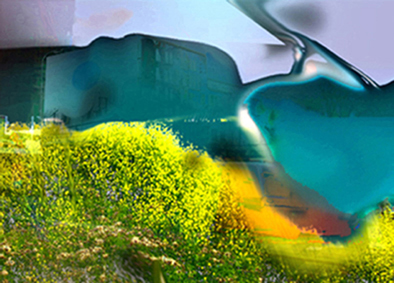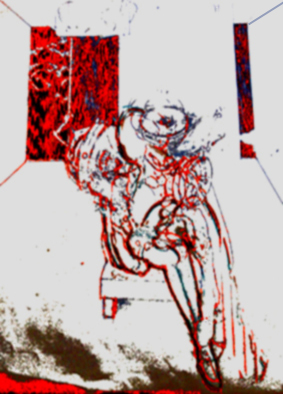
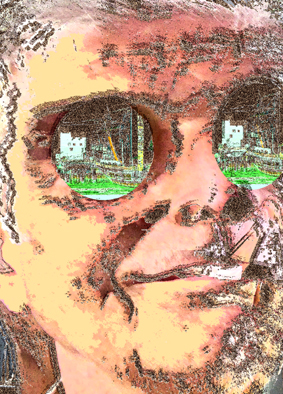
Dario at ARTiculAction (1): Hello Immo, and a warm welcome to ARTiculAction. I would start this interview with my usual introductory question: what in your opinion defines a work of Art? By the way, what could be in your opinion the features that mark an artwork as a piece of Contemporary Art?
Immo: My definition of an art work in general combines the criteria Idea, Object/subject and techniques in it's quality while contemporary art is always spacetime bound, the space time it was or is made in.
Dario at ARTiculAction (2): As a basically self-taught artist, what did you find to be the biggest challenges to improving your work through the years of your long career? In particular, are there any experience that has impacted on you and on your development as an artist?
Immo: The missing of my father in the first 8 years because of the beginning of world war 2 that caused a now slowly ending for some kinds of distortions, my drawing works at school, my attempts to find my right way in a world of hopeless desease. Meeting the painter Jens Cords in Hamburg who impressed me with his acribic handling of the oil colors in nature studies. Amsterdam 1969 when I was working as an Art instructor for the Famous Artits School that opened some new ways to draw and paint while explaining what and how to do so.
Dario at ARTiculAction (3): By the way, what particular artists, if any, did influence you during your early years of painting and how did you first come across their work?
Immo: Reading and studying books about Leonardo da Vinci, Hercules Seeghers one of Rembrandt van Rijn's teachers, Paul Cezanne, Gauguin, Modigliani, Marc Chagall, Wassily Kandinsky, Vincent van Gogh, Paul Klee, Giacometti, Oskar Kokoschka, later Francis Bacon and many others. Corneille and Martin Kippenberger I met personally. Some of them in the Kunsthalle Hamburg.
Dario at ARTiculAction (4): Before starting to elaborate about your production, would you like to tell to our readers something about your process and set up for making your artworks? In particular, what technical aspects do you mainly focus on your work? And how much preparation and time do you put in before and during the process of creating a piece?
Immo: In my early years (round about at the age of 18 I was sitting together with a school friend outside on the meadows drawing the landscapes with pencil, color pencil and ink. I did linol cuts associating natural impressions. At my 21th birthday I got an oil color set and started with natural impressions ranging from landscape views to plant structures under the microscope that fascinated me. Later I went to Sweden and made some scetches here and there. 1962 I first travelled to the Netherlands (Dordrecht) sitting outside in the lands making series of ink drawings on paper.
Dario at ARTiculAction (5): Now let's focus on your art production: I would start from Evelyn and Imageproof


Immo: Living alone on Ibiza (Spain) in the years 1965 1968 at the age of 27 I made drawings (scetches) from posing girl friends that I had met there. This pencil scetches formed the base I was working out later in oil on canvas while keeping their personality in mind (Evelyn has originally been one of them drawn on paper with pencil, color pencil and ink.) Later I photographed this drawing/s and worked it/them out with Photoshop (over expressing "Evelyn" being in great fear of the dentist). "Imageproof" is based on a photo of myself that went through many stages of sizing and resizing, color changes, copying another picture in transparent modus into it, setting slight corrections here and there, again some color corrections until I was somewhat satisfied with the expression of myself as taking up a kind of imprint from my surroundings.
Dario at ARTiculAction (6): Multidisciplinarity is a crucial feature of your artistic approach: in particular, in these years you have dedicated yourself to Computer Art and I have highly appreciated the effective synergy between different materials and techniques that you have been capable of establishing by replacing the easel with a computer monitor and the palette of oil colors with digital graphics programs while crossing the borders of different techinques have you ever happened to realize that a synergy between different techniques is the only way to achieve some results, to express some concepts, especially in modern times?
Immo:
Yes indeed. Crossing the border from oil paintings to computerprograms
has been an evolutionary upgrade. Working on photographies of my old
oil paintings has brought me to new concepts with new results,
especially the possibility to create tremendous variations on one
subject (theme) in relatively short time without loosing the
original. This is fascinating. Creating endless series is an
exaggeration but I often create 5, 6, 7 or some times


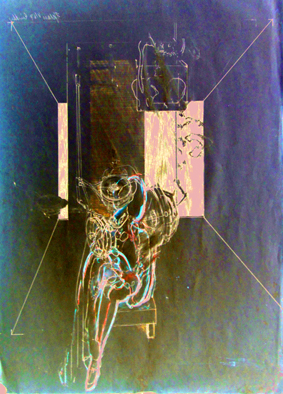
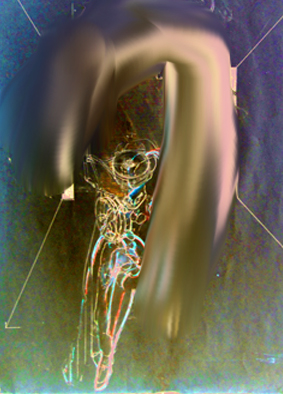
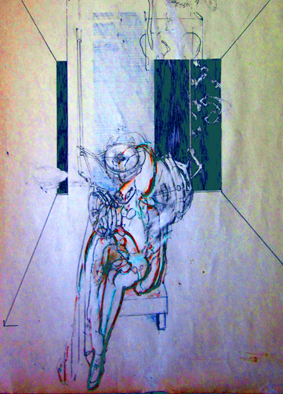

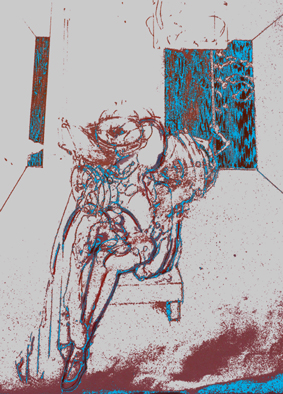


Dario at ARTiculAction (7): As you have remarked once, one of the goal of your Art is to create for the viewer worlds of images of infinite vastness that are both exciting, eerie, inspiring, images that should therefore be seen as "moments of eternity. I have highly appreciated the way your approach investigates about the concept of landscape, challenging the viewer's perception, establishing a deep involvement with the viewers, both on an intellectual aspect and - I dare say - on a physical one... so would like to ask you if in your opinion personal experience is an absolutely indespensable part of a creative process... Do you think that a creative process could be disconnected from direct experience?
Immo: Yes, I would say that the creative process can be disconnected from direct experience especially while working out different series on a or one subject (theme). Often I start with a photography working on it by copying (eventually parts), start new coloring, decoloring and recoloring, strechting, detailing forms, controlling the run of color, copying again, setting strokes, shifting forms, experimenting with cuts until not one of the original photographical pixels are left. Then starting the series or copying two picture into each other until I mostly can't remember with which photography I originally started.
Dario at ARTiculAction (8): One of the feature of your works that has mostly struck on me is the dynamicity the sense of movement that you have been capable of impressing on your pieces... and I have highly appreciated the nuance of intense tones which creates an interesting synergy rather than a contrast between such bright tones, as in Paris Intersection and in the extemely interesting Urbanshift and in Rotation which I have to admit are some of my favourite pieces of your recent ones... by the way, any comments on your choice of "palette" and how it has changed over time?
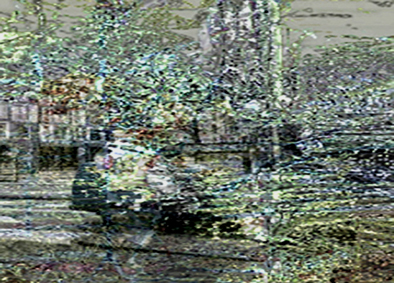
Immo: My favorite colors in my oil paintings on Ibiza where ochre and blue. Now with the computer I am up with the full color palette and all possible shapes. In Urbanshift I brought the colors extremely down to very vague tones. Urbanshift goes back to a photography I have taken on a street scene in Amsterdam near the Haarlemmer Plein. It's an amazing way from such a photography to the art work Urbanshift a development I never could have seen in advance.
Dario at ARTiculAction (9): And I couldn't do without mentioning Landsend, Landstress and Landscapethought which are part of your lansscape series ... I would dare say that these works eloquently succeed in conveying the perception of an inner harmony: moreover, I would like to stop for a moment to consider the function of the landscape suggested by this stimulating series: it has suggested me the concept that some informations "ideas are hidden", or even "encrypted" in the environment we live in, so we need - in a way - to decipher them. Maybe that one of the roles of an artist could be to reveal unexpected sides of Nature, especially of our inner Nature... what's your point of view about this?
Immo: I have practised Yoga for several years and my landscape series indeed are in some way contemplations in search for inner peace eloquently succeeded in conveying the perception of an inner harmony. That is really well observed and recognized by you. Regarding encrypted information I would like to speak about hidden forces in nature and in the world that are waiting to be discovered. Perhaps I may be trying to evoke them. I may want to evoke a resentment, a requital or revenge for some kind of hidden forces setting them into symbols. But up to now there is no key to decipher, just recentments but a constant search for it and them probably exist.
Dario at ARTiculAction (10): Dealing with your imagery, I noticed that many of your pieces are imaginary landscapes, abstract expanses or shots of cities that, as you have remarked once, seem to be taken on another planet. Many contemporary landscape artists have some form of environmental or even political message in their works: do you consider that your images could have such a political connotation in this way or do you seek to maintain a neutral approach?
Immo: No, there is no political connotation at all, more a scientific approach. As Elizabeth Hoeveler wrote in her comment on my work: " ... Immo Jalass makes us realize what scientific minds have been talking about for years if I where teaching Quantum Physics and this would be part of my tutorial even the sleepiest student would be galvanized into realizing that, not only is this art, but quantum textbook illustrations of leaping exercises. Look at these pictures ...
Dario at ARTiculAction (11): During your over 50 years career your works have been shown in several occasions: what impressions did you receive from these wonderful experiences? By the way, it goes without saying that feedbacks and especially awards are capable of supporting an artist: I sometimes wonder if the expectation of a positive feedback - could even influence the process of an artist... By the way, how much important is for you the feedback of your audience? Do you ever think to whom will enjoy your Art when you conceive your pieces?
Immo: I would say Yes and No. How much is conscious and how much is unconscious in perceiving words, written and/or spoken. It makes me somewhat happy if there is some kind of understanding as I have met it for example in E Hoevelers words as cited above and in your interview.
Dario at ARTiculAction (if you like, we could pubish some photos from your recent exhibitions)
Immo: Good idea. I would like it.
Dario at ARTiculAction (12): Thanks a lot for your time and for sharing your thoughts, Immo. My last question deals with your future plans: what's next for you? Anything coming up for you professionally that you would like readers to be aware of?
Immo:
First many thanks to you for your interesting and understanding questions regarding my art work.
I really enjoy to answer. Regarding my future I only want to say: Just going on!.
I have nearly no idea what is to come up. Often I am asking myself if more technical support
(features, possibilities) regarding the programs I am working with could or would influence
and/or develope my work. Some times I am thinking that it would be great if this or that new
feature would exist to do this or that in my pictures but I am relatively happy with the actual
situation.
Sure it would make me happy if I would or could sell some of my work. Ideally I would
prefer to sell just the digital file (TIFF in highest resolution together with all copyrights
documented) but who has the right digital frame at home to give it a good place. I am dreaming of
digital displays without frame with USB support in larger sizes but couldn't find such equipment yet.
Again thanks and success for us.
